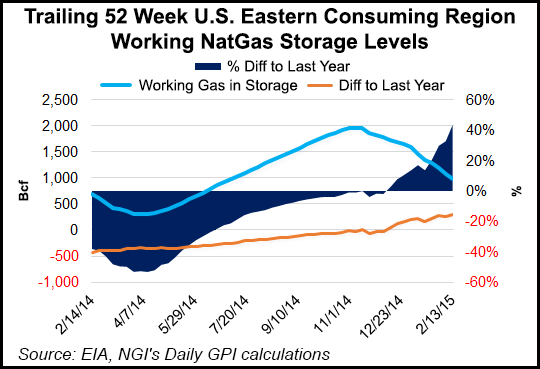Markets | NGI All News Access | NGI The Weekly Gas Market Report
Weeks of Arctic Temperatures Still Ahead for Northeast, WSI Says
Vestiges of the arctic weather that has gripped the Northeast for weeks are likely to stick around through March and even into April, but May could bring the energy-hungry region warmer-than-normal spring temperatures, according to forecasters at Weather Services International (WSI). And there are early indications that summer 2015 could be relatively mild for the eastern United States, WSI said.

“The pattern that drove the brutal cold across much of the eastern U.S. in February will retrogress a bit as we head into early March, allowing the worst of the cold to shift westward to the northern Plains,” said WSI Chief Meteorologist Todd Crawford. “This will allow more seasonable temperatures to re-emerge across much of the eastern U.S.
“Meanwhile, the weak El Nino event that impacted the pattern earlier this winter has faded, but will likely quickly be replaced by a new, stronger event as we head deeper into 2015. The return of El Nino conditions, combined with an expected lack of summer blocking and relatively cool Atlantic Ocean temperatures, will likely reduce the chances for big summer heat again across much of the eastern two-thirds of the U.S.”
The Northeast and Central United States can expect temperatures to average colder than normal in March, while the Southeast and West are likely to be warmer than normal, according to the WSI forecasters.
“Natural gas prices should find support in March, considering colder-than-normal temperatures are expected to linger through the end of the month in the eastern two-thirds of the country,” said Energy Securities Analysis Inc.’s Chris Kostas, senior power and gas analyst. “While exceptional gains in shale gas production, combined with mild temperatures during the first half of winter, will push gas prices lower, above-normal heating demand in February and March should help to stabilize and firm gas prices during the second half of the winter.
“Mild temperatures in the West in March should partially offset the increased energy demand of the East, although with most heating demand east of the Rockies (due to colder seasonal temperatures and larger population), the offset associated with mild western temperatures should be minimal. Mild western temperatures have kept western snowpack well below-normal this winter, which will reduce hydroelectric supplies later this year. We expect natural gas inventories will finish the withdrawal season near 1,600 Bcf, just below the five-year average of 1,650 Bcf.”
The Energy Information Administration on Thursday reported a withdrawal of 111 Bcf for the week ended Feb. 13, leaving natural gas inventories at 2,157 Bcf (see Daily GPI,Feb. 19). That’s 678 Bcf greater than at the same time last year and 58 Bcf above the five-year average. In the East Region, 97 Bcf was withdrawn, and the West Region saw inventories increase by 4 Bcf. Stocks in the Producing Region declined by 18 Bcf.
The Northeast should still average cooler than normal in April, as will the Southeast, while the North Central area can expect warmer-than-normal temperatures, the forecasters said. The forecast temperatures in the Northeast, coming during a month when weather-related energy demand is typically soft, “won’t have a significant price impact on power or gas prices in PJM, New York or New England,” Kostas said.
“The warmer-than-normal temperatures expected in the West should keep electrical loads slightly firmer than normal in that region, although loads are not expected to be firm enough to result in significant impacts on implied market heat-rates. Reduced hydroelectric supplies related to below-normal snowpack in the Northwest this winter could help to support western power prices slightly as electrical loads begin to increase, however.”
By May, all of the eastern United States and the nation’s northern tier are forecast to be dominated by warmer-than-normal temperatures, with only the South Central and Southwest areas averaging cooler than normal, WSI said.
“While natural gas prices are expected to be relatively soft in May (due to the year-over-year increase in natural gas production), warmer-than-normal temperatures over most of the country should help to firm implied market heat rates as electrical loads begin to increase later in the month,” Kostas said.
© 2024 Natural Gas Intelligence. All rights reserved.
ISSN © 1532-1231 | ISSN © 2577-9877 | ISSN © 1532-1266 |
